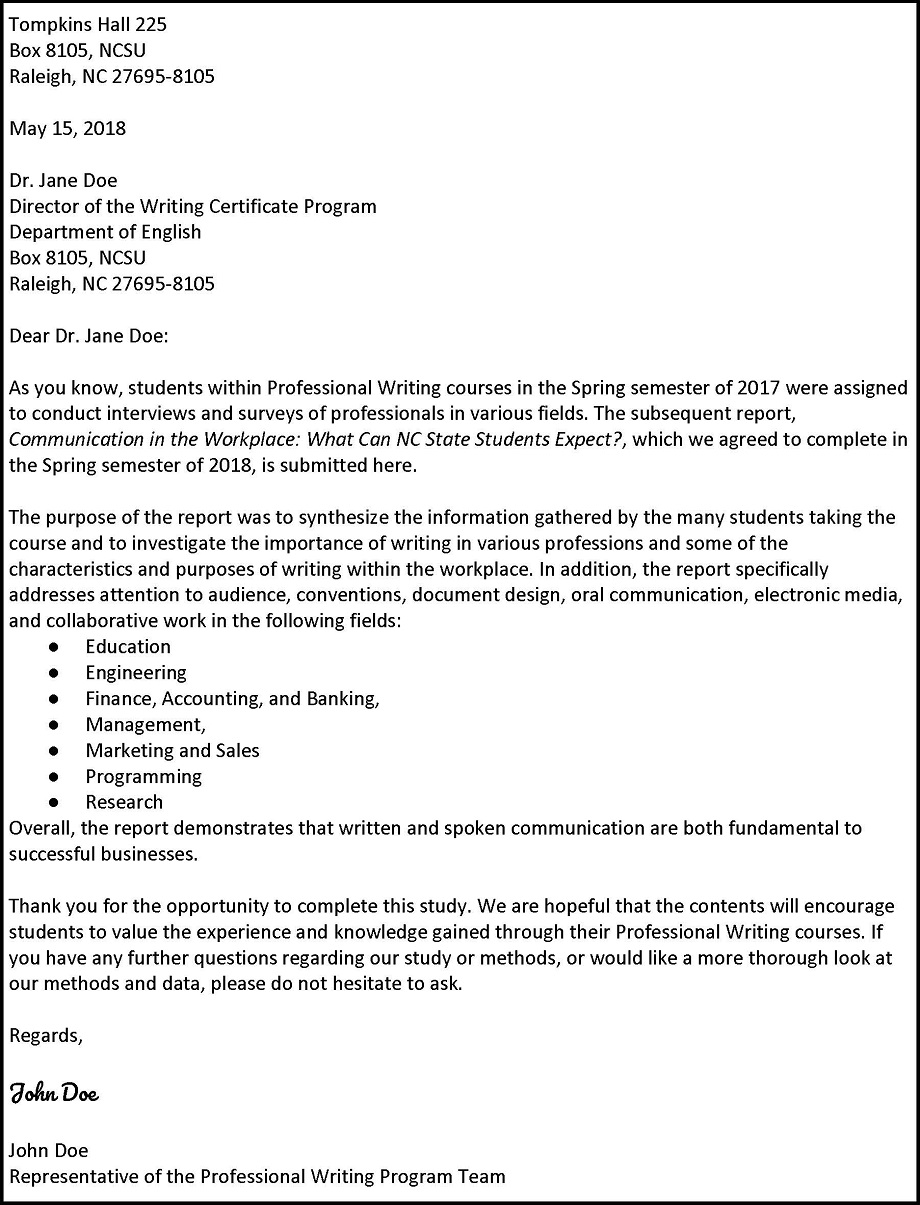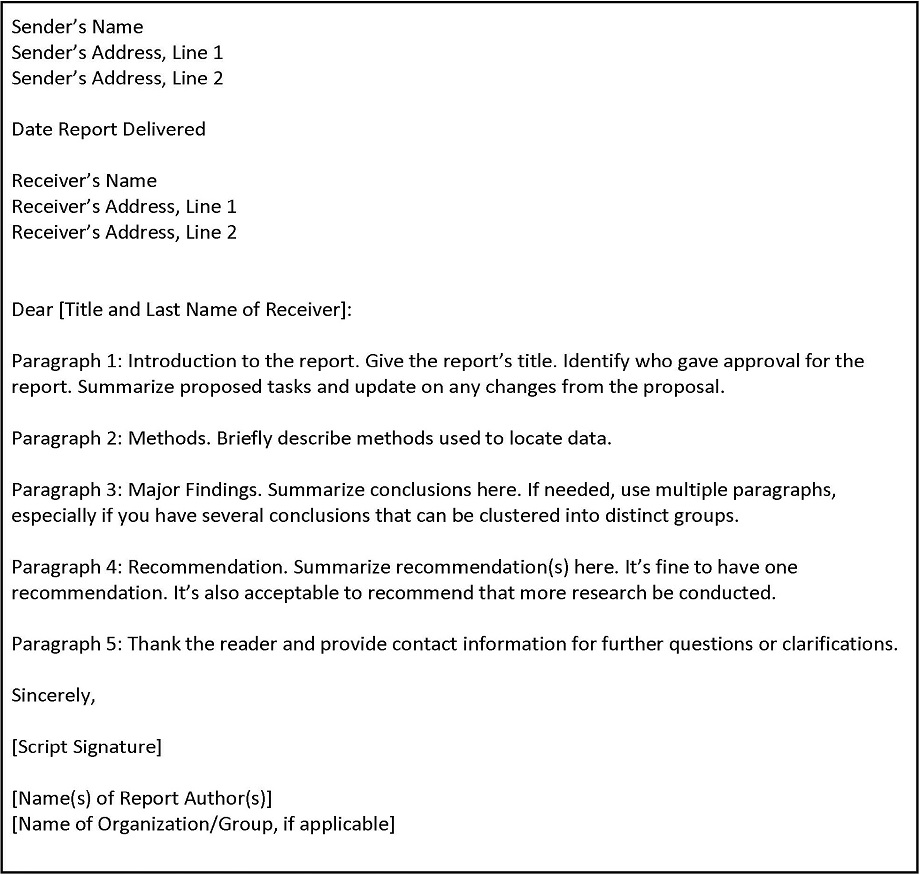Chapter 13: Write a Transmittal Letter
Kat Gray; Dawn Atkinson; David McMurrey; Annemarie Hamlin; Chris Rubio; Michele DeSilva; Nicole Hagstrom-Schmidt; Matt McKinney; and Kalani Pattison
Introduction
To complete Project 4, you will write one final document with your group: a transmittal letter to accompany your grant proposal package. Transmittal letters are a common genre of professional correspondence, in which writers sum up the contents of a document package and give readers directions about how to interact with those materials. Rhetorically, the transmittal letter is an opportunity for you to engage your reader with care by introducing your team members, the process of creating your project, and the reasons behind your work.
Below, you’ll learn more about transmittal letters, a subgenre of cover letter designed for a specific purpose: to accompany a package of materials (like a report or a grant proposal). The sections below discuss the rhetorical situation of writing a transmittal letter, what type of content goes into your cover letter and how to organize it, and what type of writing style you should use for transmittal letters. You will also find a sample transmittal letter and a template for writing transmittal letters, both intended to help you and your group decide how to organize your document.
Writing a Transmittal Letter[1]
A transmittal letter is a communication from you (the document writers) to the recipients (the people who requested the document). Essentially, this letter says, “Here is the document we agreed that I would complete by a certain date. Briefly, it contains these components and materials. It does not cover these topics or materials. Contact me to let me know your thoughts when you have had a chance to read it.” The transmittal letter also explains the context or the events that brought the report about.
Rhetorical Situation
The rhetorical situation for your transmittal letter is slightly different than the rhetorical situation for the other documents you have created during this project. Your audience is your professor; the purpose of the cover letter is, broadly, to orient your instructor to the materials you have submitted for project 4; and your context is that you are turning in your project and want your reader (your instructor) to have a clear picture of what you have submitted, and why.
The transmittal letter precedes the rest of your document, even your title page. As a result, it is not counted as part of your document’s page count. The transmittal letter for Project 4 has several purposes:
- To supply details about the accompanying document: what it is, who it is intended for, and key information provided in the document;
- To account for your (or your team’s) process – how you created the grant proposal project and research remix, what feedback you received, and how you revised, based on that feedback;
- To offer answers to readers’ potential questions – anticipate beforehand what they might ask;
- To provide the writers’ contact information.
Letter Contents & Organization
As with other types of correspondence you’ve written this semester, transmittal letters follow an introduction, body, and conclusion format, although these sections may also be expanded as needed. If you decide to add sections, consider using headings to help readers navigate the document.
The contents and organization of a transmittal letter are:
- First paragraph. Provides details about your group project. What is your project? What documents have you included? What information do you provide in your documents? Give a brief overview of your project’s organization.
- Middle paragraphs. Discuss the process you and your team used to produce your project. You should create paragraphs addressing the following topics, at least:
- Why did you choose this topic? Who are you hoping to help?
- What process did you and your team use to create both the grant proposal and the multimodal remix? How was each team member involved?
- What feedback did you receive on your documents? How did you revise your project based on that feedback?
- Final paragraph. Encourages the reader to get in touch if there are questions, comments, or concerns. It closes with a gesture of goodwill, expressing hope that the reader finds the document satisfactory, and maintaining an ongoing professional relationship with the reader.
As with any other element in a report, you may have to modify the contents of this letter (or memo) for specific situations. For example, you might want to add another paragraph listing questions you’d like readers to consider as they review the report. Figure 13.1 shows what this might look like.
In the template of the letter of transmittal that follows in Figure 13.2 notice the standard business-letter format. If you write an internal report, use the memorandum format instead.
Example Transmittal Letter
The example transmittal letter in this section contains the characteristics discussed above. Review the letter for an example of what transmittal letter content might look and sound like. Pay particular attention to how the writer uses his professional persona to communicate with the reader.
You can note the following characteristics in Figure 13.1, below:
- Standard letter formatting: This letter makes use of business letter formatting, starting with the inside address (containing the letter writer’s address, followed by the date, followed by the recipient’s address). Then, the letter uses a salutation to great the reader before beginning the letter in earnest. The letter closes with a complimentary close and a signature, which includes the writer’s professional title.
- First paragraph: reminds the reader of the document’s topic, gives its title, and reminds the reader that she requested the enclosed information.
- Second paragraph: clearly explains the document’s purpose; overviews document topics; previews conclusions.
- Third paragraph: expresses thanks to the reader for engaging with materials; hopes for what the document can do; how to request further information.

Figure 13.1. An example of a letter of transmittal. (Alternative PDF version: Figure 13.1.)
Transmittal Letter Template
The template below gives your group an outline to use for the transmittal letter’s format and contents. Unlike the example letter above, this model uses five paragraphs – expanding the middle section of the letter from one paragraph to three. The number of paragraphs your transmittal letter includes is up to you – but you should organize the letter in a way that makes sense. Like any letter, make sure that each paragraph has one clear main idea, and build from there.
Be aware that for Project 4, your transmittal letter takes place of your revision note. It therefore contains some of the same information – specifically, it should contain information about what feedback you received, and how you used it. You should also consult with your instructor as you create your transmittal letter. Make sure that you have a clear understanding of what information your instructor would like to see.

Figure 13.2. Template for letter of transmittal. (Alternative PDF version: Figure 13.2.)
Writing Style
Establish yourself as a competent professional who takes readers’ perceptions into account by composing correspondence that communicates in a constructive manner. The following tips, adapted from Last (2019, pp. 39-40), specify what a constructive communication approach entails.
- Write from one adult to another: Aim to communicate respectfully, responsibly, confidently, and cooperatively—as one mature adult to another. Use your professional persona to speak to stakeholders and clients, in addition to team members, managers, or executives.
- Be genuine: Articulate reasonable viewpoints that can be backed with concrete evidence. Commit to making improvements when errors occur, but think carefully about whether to use I or we in such situations. Readers may interpret we in the context of a company memo or letter to mean the company as a whole, while I clearly points to the writer.
- Be courteous: Keep the reader foremost in your mind by prioritizing that individual’s viewpoint. When addressing a specific person in a memo or letter, the words you and your are acceptable and can be used to create reader-focused writing, as the examples in the table below (Table 13.1) show.
| Writer Centered | Reader Centered |
| If I can answer any questions, I will be happy to do so. | If you have any questions, please ask. |
| We shipped the order this morning. | Your order was shipped this morning. |
| I am happy to report… | You will be glad to know… |
| We cannot process your claim because the necessary forms have not been completed. | Your claim can be processed as soon as we receive the necessary forms. |
In memo and letter style, aim to use everyday language that target readers will likely understand without difficulty. To this end, avoid correspondence clichés – overused sayings and strings of text that are stale, wordy, and hold little meaning for readers. Instead, select precise words that articulate your exact meaning to encourage message comprehension. Table 13.2 lists clear, concise wording that can be used in place of common correspondence clichés.
| Cliché | Alternative |
|---|---|
| Without further delay | Now |
| Until such time as | Until |
| Due to the fact that | Because, since |
| First and foremost | First, firstly |
| Last but not least | Lastly, finally |
| In the event that | If |
| Despite the fact that | Although |
| Pursuant to our agreement | As we agreed |
| In many instances | Often |
| In the course of | During |
| In view of the fact that | Because, since |
| Per our conversation | As we discussed |
| To whom it may concern: | Dear XXX: (replace with the recipient’s name) |
Finally, think carefully about your tone. Speak frankly, clearly, honestly, and with empathy for your reader and what they need to get out of your document. Make sure your purpose is clear early in the letter and help the reader to understand how to use the information in the letter to help them understand the documents that follow. Consider your reader to determine the level of formal vs. informal language you should use; it’s always better to err on the side of formality in a professional situation.
Conclusion
In the professional world, a transmittal letter serves as an introduction – to you, to your organization, and to your project. Transmittal letters are a simple way to make a good first impression by being clear, concise, and well-organized in the way you communicate information about your documents to your reader. Be clear about who you are, what you value, and how those things are centered in the work you will present.
References
Last, Suzan. (2019). Technical writing essentials: Introduction to professional communications in the technical fields. University of Victoria. License: CC-BY 4.0. Retrieved 18 July 2025, from https://pressbooks.bccampus.ca/technicalwriting/.
Swarts, Jason, Stacey Pigg, Jamie Larsen, Julia Helo Gonzalez, Rebecca De Haas, and Elizabeth Wagner. (2018). Communication in the Workplace: What Can NC State Students Expect? North Carolina State University Professional Writing Program, 2018. Retrieved 18 July 2025, from https://docs.google.com/document/d/1pMpVbDRWIN6HssQQQ4MeQ6U-oB-sGUrtRswD7feuRB0/edit#heading=h.n2a3udms5sd5. Licensed under a Creative Commons Attribution 4.0 International License.
- Based on David McMurrey, Annemarie Hamlin, Chris Rubio, Michele DeSilva, Nicole Hagstrom-Schmidt, Matt McKinney, and Kalani Pattison, "Front Matter," in Howdy or Hello? Technical and Professional Communication and Dawn Atkinson, "Writing Print Correspondence," in Mindful Technical Writing. ↵

